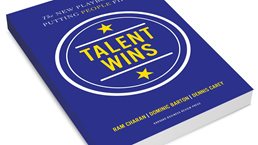In our combined 90 years of advising CEOs and their boards, the three of us have never come across a moment like this, when virtually every CEO we work with is asking the same daunting set of questions: Are my company’s talent practices still relevant? How can we recruit, deploy, and develop people to deliver greater value to customers—and do so better than the competition? How can I be sure that I have the right approach to talent—and the right HR—to drive the changes we need to make?
Stay current on your favorite topics
We sought to answer these questions in our new book, Talent Wins, which explores what it takes to build and lead a talent-driven organization. The list of critical priorities, which includes everything from continual, agile reorganization to the reinvention of HR and the creation of an external M&A strategy, is long—and it creates a complex set of challenges for the CEO. The experiences of CEOs at talent-driven companies such as Amgen, Aon, Apple, BlackRock, Blackstone, Facebook, Google, Haier, Shiseido, Tata Communications, and Telenor suggest that meeting those challenges requires a distinct set of mind-sets. As we show in the book, leaders at talent-driven companies are as focused on talent as they are on strategy and finance. They make talent considerations an integral part of every major strategic decision. They ensure that their own focus on talent is woven into the fabric of the entire company. And they are comfortable leading flattened organizations—often centered around the work of small, empowered teams—built to unleash the talent that will drive outsize value.
Would you like to learn more about our People & Organizational Performance Practice?
How do you become such a leader, and lead such a company? This article focuses on four key priorities for the CEO. The first two are moves the CEO must make to secure alignment at the top of the organization. Misalignment at the top is trouble for any company, but it is disastrous for talent-driven ones, where HR and finance must work in tandem and the CEO must oversee a complex, fluid structure. With that foundation in place, CEOs can turn their attention to the two most critical aspects of leading a people-first company: finding, recruiting, developing, and deploying key talent; and ensuring that talent is truly integral to every major strategic decision across the organization.
Lead with a G-3
The talent-driven organization needs a central brain trust, and all that we’ve seen argues for it being a “G-3” consisting of the CEO, CFO, and chief human resources officer (CHRO). Why these three executives in particular? Because deploying financial capital and human capital together is the key to success. “People allocation is as powerful as financial allocation,” explains Aon CEO Greg Case, who works closely with CHRO Tony Goland and CFO Christa Davies to make sure the company has the right talent to meet the challenges of the future.
By putting talent and finance on equal footing, the G-3 will change the way and sequence in which critical matters are discussed. This trio of top executives doesn’t turn to personnel and organizational issues only after having reviewed financial results and strategic initiatives across each business unit, as typically happens today. “We work together to make talent decisions and integrate solutions,” says Case. “Pure capital allocation is essential, but that’s not enough. Do we have the right talent in place? How should we think about talent development? If you have an opportunity to acquire a company, do you have the right people in place to do the deal and operate it afterward? It’s not a matter of getting input from my team so I can make a decision. The three of us work together as peers and answer those strategic questions as a team.”
People allocation is as powerful as financial allocation.
The G-3 isn’t just focused on talent as some discrete item on the agenda. Instead, the G-3 ties talent to every item on the agenda. Consider the turnaround over the past few years at McGraw-Hill. In 2010, Wall Street was punishing then-CEO Terry McGraw’s company. The reputation of its S&P ratings service had been damaged in the financial crisis, and investors didn’t see any synergy with the conglomerate’s other assets, an educational publishing arm and a collection of media properties. McGraw relied on his new CHRO and CFO, John Berisford and Jack Callahan, to evaluate the company from their perspective as outsiders and tell him how to unlock value.
Working together and meeting constantly, both formally and informally, Berisford and Callahan were able to evaluate the company holistically. They discovered pockets where paternalistic practices had fostered bureaucracy at the expense of innovation. They also discovered that Wall Street was right—there were no real synergies between the divisions. With McGraw, they decided that the only way to unleash the talent within was to engineer a breakup—S&P as one company, education and media as another—and sell assets that didn’t fit. It was a plan that McGraw, who had been at the company since 1980, might not have been able to design without his CHRO and CFO. Once the board agreed, Berisford and Callahan led the exercise of splitting the company. Again and again, their respective experiences came together to deliver unified solutions to tough problems: compensation levels at both companies, the bottom-line impact of key personnel in critical roles, and a leadership structure for the stand-alone education business. Callahan got the facts, Berisford figured the human equation, and together with McGraw they arrived at holistic solutions. “If finance and HR aren’t talking,” says Callahan, “they aren’t creating new value.” While the education company is privately held, the market cap of S&P is four times higher than the value of McGraw-Hill in 2010, when Berisford and Callahan joined.
As the example suggests, CEOs in a G-3 will demand much of their CHRO, perhaps more than they ever have. Ed Breen, who turned around Tyco before signing on as CEO of DuPont, says, “You’re going to be more brutally honest. The CHRO and the CFO might have to tell the CEO that someone he’s very close to in the organization isn’t an A-plus player. That’s how you’ll come to better decisions.” Breen’s former CHRO at Tyco, Laurie Siegel, believes the CHRO of a talent-driven organization must be a great business person, not just a great people person. “The conversation with a CHRO,” she says, “is not, ‘We can’t do it.’ Instead it’s, ‘Here’s how we can get there.’ What you want is a CHRO who is a problem solver, not a deal killer.” That’s why line experience should become a central part of the career path of any HR executive who shows real leadership potential. And just as the CHRO must understand the key financial drivers, the CFO must understand the human drivers of value creation.
One word of caution: the success of the G-3 depends on the CEO’s commitment, attention, and care. It doesn’t just happen because the CEO hires a great CHRO and a great CFO. McGraw elevated the CHRO, set a tone of openness and intellectual honesty, fostered a close rapport in informal chats and formal weekly meetings, and gave the G-3 a mandate that was as broad as his own. The CEO is the lynchpin of the G-3. With his or her strong leadership and support, a G-3 is the best way to ensure that the value of talent is represented in every major decision.
Align the board of directors
One of the ironies of today’s agile, flatter structures is that they can’t succeed without commitment and alignment at the top. Transforming a company to be a talent-driven organization requires a top-down revolution. CEOs who try to drive this kind of change must have the alignment of both senior management (starting with the G-3) and the board of directors.
The talent-driven CEO wants the board to focus on two forms of “TSR”: not just total shareholder return, but also talent, strategy, and risk.
The role of the board is often underplayed in discussions around talent. That’s because so many boards focus on strategy and compliance first, and limit talent discussions to the question of CEO succession and executive compensation. But CEOs running a talent-first organization must help the board see that talent is the value creator and therefore belongs at the top of its agenda. The talent-driven CEO wants the board to focus on two forms of “TSR”: not just total shareholder return, but also talent, strategy, and risk.
It’s a profound change, but most directors will welcome the shift. According to a recent McKinsey survey of corporate directors, most believe they are effective on strategy, yet very few feel they are doing a good job developing people and ensuring that the company has a strong, healthy culture.
How to drive this shift of mind-set? A critical move is to transform the mandate and scope of the compensation committee. Just as many audit committees have evolved into bodies focused on strategic financial allocation, the compensation committee must evolve into a group focused on the recruitment, deployment, and development of talent. That’s why it should be given a new name, such as the talent and rewards committee, or perhaps the people committee.
The name change has symbolic value, given that most compensation committees are noteworthy only when they overpay their CEO. A talent and rewards committee, on the other hand, promises to focus on a wider group of executives and to look more holistically at how to maximize the quality and effectiveness of talent throughout the company.
The talent and rewards committee can lead activities that are of great value to the talent-driven CEO: everything from recruiting to regular evaluations of the critical talent-development system. Talent will no longer be an afterthought. Instead, every meeting of the board of directors must include a discussion of not just CEO succession but also the health of a wider swath of top talent (which one might call the “critical 2 percent”) and diversity.
The board of Telenor, the Norwegian telecom, offers a good example of how a board that is focused on talent can support a people-first CEO. Just 22 percent of the company’s leaders are women, but CEO Sigve Brekke hopes to increase that number to 30 percent by 2020. Directors are updated on diversity at every meeting, and they engage at a deep level: chairperson Gunn Waersted, like three of the other nine directors, is a woman. Waersted also leads the people and governance committee, which used to be called the compensation committee. This kind of involvement is how directors can help an “HR issue” such as gender diversity become a competitive advantage. “What we see,” says former chief people officer Jon Erik Haug, who left the company in December 2017, “is that by focusing on gender we stand out in some markets, like Asia, because our competitors are not focusing on it.”
Constantly develop your top talent
In his former role as operating partner at Blackstone, Sandy Ogg often worked with the leadership of the private-equity giant’s portfolio companies. One company’s value agenda was to increase earnings from $600 million in earnings before interest, taxes, depreciation, and amortization (EBITDA) to $1 billion, while shifting the multiple from eight to ten. Using an approach that he had developed while working with other companies in the portfolio, Ogg identified the pivotal roles in the 12,000-person organization. He boiled it down to 37 critical positions, one of which could single-handedly generate $60 million in EBITDA. The men and women in those 37 critical roles held the fate of that investment in their hands. Ogg, along with the company CEO and the rest of the Blackstone team, then took the time to ensure that those positions were filled with leaders who were up to the task ahead.
Thirty-seven people in a 12,000-employee company! In almost every organization, success depends on a small core of people who deliver outsize value. The success of the talent-first CEO largely depends on how he or she leverages this critical 2 percent of people. (That 2 percent figure is merely a guideline; in big corporations, the “2 percent” may be a group of fewer than 200 people.)

Talent Wins: The New Playbook for Putting People First
Knowing where to look is important. According to one McKinsey study, about 70 percent of senior executives are wrong about who is most influential in their organization. The G-3 must pinpoint the company’s crucial decision nodes, the places in the organization where important choices are made by people who can drive tremendous value. Who is really exercising power at those key points? (Often, it’s not the official decision maker.) How do decisions at those nodes create or destroy value? The 2 percent is most definitely not limited to group of employees with the fanciest titles in the company. Instead, this high-leverage group can include key designers, scientists, salespeople, up-and-coming leaders, influencers, integrators, and support staff tucked away in unglamorous corners of the company. Jony Ive, Apple’s chief design officer, is obviously one of the 2 percent at the company, as is Steven Nissen, star cardiologist and chairman of cardiovascular medicine at the Cleveland Clinic. But so, for that matter, is the navigation team at United Parcel Service, whose software, which encourages drivers to take as few left-hand turns as possible, saves the company millions of dollars each year on gas.
Identifying the 2 percent is just one part of the continual process of talent development. At a talent-first company, pay scales and new opportunities are often rewarded “unfairly.” As Laszlo Bock, Google’s former CHRO, writes in his book, Work Rules!, “At Google, we . . . have situations where two people doing the same work can have a hundred times difference in their impact, and in their rewards. For example, there have been situations where one person received a stock award of $10,000, and another working in the same area received $1,000,000.” While this isn’t typical, bonuses for the best performers can be five times higher than for the rank and file. High-performing workers at junior levels in the company can earn more than average performers working at higher levels.
This devaluation of hierarchy in favor of meritocracy opens up opportunities for the most talented people at any level of the company. Tadashi Yanai, CEO of Fast Retailing, whose brands include Uniqlo and Compte des Cottonniers, believes that digital changes everything for anyone selling anything. To prepare Fast Retailing for that future, he isn’t relying on his most experienced people. As he puts it, “To tell the truth, my high-level executives are very good in the day-to-day nitty gritty, but we need a fresh perspective.” Instead, he’s turned to 38 young workers from all corners of the globe and all levels of the company.
CEOs of talent-driven companies use every tool at their disposal to develop their critical 2 percent. When a company doesn’t have the skill sets or the innovation firepower it needs for the future, it’s up to the CEO to go out and recruit “people who can generate better ideas than other people,” as Shiseido CEO Masahiko Uotani says. The CEO must ensure that the company has cutting-edge analytics software that can help track the progress of these key executives, and even evaluate the likelihood of success in the next steps on their career paths. The CEO must be sure that the company is constantly creating the next generation of leaders. At BlackRock, for example, one criterion used in evaluations of top executives is their ability to create new leaders. As chief talent officer Matt Breitfelder explains, “By design, we create some social pressure in the organization by asking our managers, ‘Yeah, you think of yourself as a leader, but what’s your track record? Name the people that you’ve developed.’ We call it positive paranoia.”
Unleash talent and strategy with agility
When CEOs of talent-driven companies launch new initiatives, they make sure to have the right talent on hand before going too deeply into strategic and financial planning. Agile organizations built around empowered teams are the best way to constantly and nimbly match the right talent to the right strategic initiatives.
A few years ago, Facebook CEO Mark Zuckerberg decided that his company had to make a dramatic shift from a desktop business model to a mobile one. Zuckerberg’s vision was clear: He told product teams, “Come in with mobile. If you come in and try to show me a desktop product, I’m going to kick you out.” That clear vision, of course, guaranteed nothing: the CEO graveyard is full of visionaries who fell back to earth when their teams couldn’t deliver. But Facebook did deliver. Every product team got a mobile developer. Desktop products in development were simply dropped. The teams delivered a slew of mobile offerings. Not all were hits, but enough made the cut—by the end of 2016, mobile accounted for 84 percent of the company’s ad revenue.
Agile organizations built around empowered teams are the best way to constantly and nimbly match the right talent to the right strategic initiatives.
Priority initiatives like the mobile shift are supported, says Facebook CHRO Lori Goler, by a culture of autonomy and initiative. People find their way to projects that interest them. Some teams stay together for years, others disband after just a few weeks. The organization constantly reorganizes itself. Facebook still faces multiple challenges, of course, such as managing user data. Solving these dilemmas could tax Zuckerberg’s historic ability to provide a clear vision and aggressively deploy talent to effect the change he seeks.
It’s not just technology companies that have embraced the principles of agile organization. Another, perhaps familiar, example of how agility can connect talent and strategy is Haier, the Chinese appliance manufacturer. Two thousand microenterprises are the basic innovation units of the company’s organizational grid, each composed of 10 to 20 people drawn from a range of functions. Like Facebook’s teams, some units stay together for years, while others disband within weeks. Each unit is ferociously focused on a set of customers who use its particular product. The units are empowered to find the solutions their customers need, as opposed to being tasked to sell them a particular product. The solutions created by these microenterprises drive Haier’s product strategy. Giving talent so much power might seem daunting, but it’s hard to argue with the results: Haier is now the world’s largest appliance maker.
Haier CEO Zhang Ruimin says that today’s CEOs must learn how “to lose control, step by step.” That’s a challenge for anyone comfortable with top-down leadership. But note the second ha lf of Zhang’s quote: “step by step.” Leading a talent-first organization is something that must be managed incrementally. The steps it requires—alignment at the top; continual development of talent; a commitment to link talent and strategy; an agile, flexible corporate structure; and others that we discuss in our book—are each important. But built one upon the other, they trigger a multiplier effect that can exponentially increase the value that talent delivers to the organization. And that, of course, is the great promise of leading a talent-first organization: seeing new ideas lead to even better new ideas, watching the creative thinking that’s been enabled amplify itself across divisions and varying levels of seniority and expertise, and reaping the benefits of explosive value that arises from expected, and unexpected, parts of the company.


